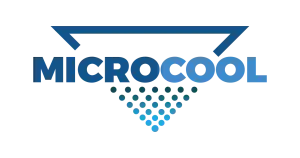Evaporative fog balances dry conditions in a controlled growing environment.
Cannabis growers endorse indoor growing because they can manage every aspect of the environment to coax the plant to optimal growth. Managing cooling, heating, relative humidity (Rh) along with VPD (vapor pressure deficit) level is essential for maximizing plant growth. The correct VPD range can optimize cannabis growth by:
Keeping stomata open • Maximizing CO2 uptake • Minimizing plant stress • Better managing water and nutrient uptake
Utilizing Fog to Influence VPD
Adding fog increases humidity thereby lowering VPD. Lower VPD influences the plant to open its stomata. When adding CO2 to plants at this stage, there is less waste and more CO2 absorbed by the plant.
MicroCool’s sophisticated FOCUS system adds a consistent source of humidity. By controlling VPD levels this way, growers can focus on other variables to optimize and control the plant’s growth and quality.

Reducing plant stress caused by VPD levels that are too high or too low allows the plant to better respond to optimized CO2, temperature and lighting conditions.
Delivering Grower-Specified Relative Humidity (Rh) Levels
MicroCool’s consistent humidity system delivers grower-specified Rh levels throughout a room. Since adding humidity lowers VPD, Rh setpoints can be adjusted. You can also optimize levels across the plant lifecycle or balance relative humidity affected by HVAC or lighting. The settings can be tailored to grower specs.
At various stages of development, these plants need specific and stable humidity conditions. MicroCool recognizes your need for controlling humidity and enables you to change RH setpoints depending on your gardening discretion. This is your cue for creating a smart garden of your own.
All you are required to do is to plug into your existing controls/sensors or use MicroCool’s controls to determine relative humidity and temperature settings. Smart garden sensing and controls allow for ‘zoning’ and additional rooms. It can be one of the most important aspects of your indoor garden kits.

Indoor Grow Challenges
Grow lights and air conditioning remove moisture from the air.
Cannabis is a flowering plant, that thrives best in warm climates that must be duplicated inside the indoor grow environment. When growing top-shelf cannabis, temperature and humidity are crucial variables, and optimal conditions emerge during the plant’s growth cycle. Indoor growers must then rely on artificial lighting, whether a led grow light or full spectrum led lights, to cultivate these plants.
Plants require both lights and a stable temperature profile to flourish and produce large flowers to harvest. There is no avoiding this fact. Plants will not grow without adequate lighting, and less-than-optimal lighting will result in poor yield and low-quality flowers. So, you always have to get the light settings right as a master gardener. By better managing the temperature, lighting and relative humidity inside the indoor space, master gardeners create the environment needed for these plants to achieve optimal results.
Required VPD levels change across the plant’s lifecycle.
Seedlings or young cuttings do best at humidity levels above 70%. During these crucial or early stages of development when root systems develop and expand, high humidity levels aid in the plants’ retention of moisture. Temperatures of 70 to 75 degrees Fahrenheit are optimal at this point in the growth cycle.
The humidity should be somewhat lower, with 50 to 60 percent being ideal, in plants in the vegetative phase that are rapidly expanding. Temperatures, on the other hand, should be a bit higher: 75 to 78 degrees Fahrenheit is ideal for quick development and healthy plants.
The needs of cannabis plants change during the flowering stage. Mold and fungus problems on budding buds are eliminated when humidity levels in the indoor grow chamber are reduced. At this time, humidity levels of approximately 45 percent and temperatures in the high 60s through low 70s are simply best.
Lower humidity levels and lower temperatures can help produce the greatest yield and best flavor in the strain produced around two weeks before harvest. The whole experience is different from what is obtainable in an outdoor space, and you need to be committed and precise in indoor gardens.
MicroCool’s FOCUS system alleviates many challenges through directed humidification so you can grow cannabis optimally at every stage. This is the best indoor approach to grow a smart garden for great quality and fresh herbs or a larger operation to cultivate crops.
MicroCool’s FOCUS system alleviates these challenges through directed humidification.
FOCUS Fog Humidity: Indoor Grow Environments
The one-of-a-kind FOCUS evaporative humidification system was built for indoor precision applications. It includes the Hummingbird and FOCUS pump series plus POD and CELL nozzle modules and distribution manifold. The closed-loop, high-pressure system releases the always-available evaporative fog in the smallest increments to meet a setpoint. Individual solenoids give fine control to each nozzle and prevent dripping. Growers control each module individually, as a series or ‘zone’ or throughout an entire space. Pump capacities accommodate small areas or large rooms, warehouse or workspaces.
MicroCool solutions support a wide range of indoor environments and specifications. Talk with an industrial humidification expert today!
FOCUS Pump
The FOCUS pump series includes five models that can be used independently or as part of a larger system: 4 floor based units and the wall-mounted HUMMINGBIRD ( delivering up to 1200 lbs fog /hr. ) Unique in design, the pumps provide continuous high-pressure to the system allowing for instant on/off capability. Multiple levels of filtration and UV light sterilization ensure superior hygienic water quality and save on sourced water. The latest VFD (variable frequency drive) technology is energy savvy allowing soft start and is built for long life performance.
The HUMMINGBIRD is a small-capacity, all-in-one pump with all the features of the larger pump but is best suited for single rooms and smaller spaces. Adding the optional temperature/humidity sensor makes the HUMMINGBIRD a complete standalone system for smaller applications.
Reverse osmosis water is required for use with the FOCUS system.
- Variable speed drive — Allows the pump to softly start and operate depending on system demand
- Daily Hygienic Flush + UV Light — Keeps water moving, sterilizes water on bypass killing 99.9% of bacteria and minimizes contaminants
- Flexible Control — Ties into external sensors, BMS systems (analog) and climate control systems
- Control Panels built to 508A UL standard — Improves safety and reliability


POD and CELL Nozzle Modules
Each FOCUS nozzle module has a built-in solenoid for immediate operation and shut down of the fog cloud. A grower-specified set point provides consistent humidity levels – instantly. The nozzle module works with temperature and humidity sensors, MicroCool controllers or with grower controls to provide dripless operation. Configurations can be designed around available space, capacity and head room constraints. The wide array of nozzle orifice sizes and endless directional adjustments make FOCUS nozzles the perfect solution for indoor environments. In addition, the POD comes with asymmetric timer and built-in fan for spaces with little to no air movement. All nozzle modules can be controlled individually or as a group.
- Solenoid Control — Offers precise, incremental delivery. Instant on/off with dripless operation.
- Asymmetric Timer — Provides endless possibilities for on/off times, and delivers just what is needed.
- Flexibility — Adapts to limited space constraints and can be easily directed for optimal coverage.
Learn More about Humidification for Indoor Grow Environments
When it comes to indoor gardening and agriculture cultivation, you will discover how delicate and choosy plants can be. Many plants are quite sensitive and this is not just about one type of plant commonly grown indoors, like cannabis. Cherry tomatoes, for example, require 8 to 12 hours of sunshine each day, even in the winter, to thrive. While plants like this can live in a wide range of soil types, water levels, and circumstances, they do have certain optimum conditions that maximize their growth and quality potential.
As growers, we need to pay more attention to their demands, especially when these plants are grown for commercial purposes, rather than just leave them to “survive”. Plants, particularly actively growing plants, respond to humidity just like they do to temperature and light, adjusting accordingly to survive. The ideal conditions for each plant are determined by its evolutionary traits, genetics, and origin.Humidity has a significant impact on the nutrient levels of a plant since it affects the rate of water evaporation from leaves. Transpiration slows down when humidity levels are high, forcing the plant to absorb less water from the roots and therefore, fewer nutrients necessary for growth. In the long run, it affects the plant’s nutrient uptake and can leave it needing more. Humidity indeed plays a big role in the overall process of growing herbs and other plants, since it affects the plant’s growth and quality.
The degree of saturation of water in the air of your indoor garden is known as relative humidity, which is important to understand. When the absolute humidity reaches 100%, it can’t hold any more water vapor, resulting in condensation.
The relative humidity in indoor gardens is just as much a function of the amount of water vapor in the air as it is of the temperature. Relatively speaking, the amount of water vapor in colder air may be the same as in warmer air. As a result, when temperatures fall, the relative humidity rises. As temperatures rise because of LED grow lights or hot lamps, growers will need to add water to the air inside the room.
When there’s a lack of humidity in the air, water vapor is limited. This causes the plants stoma to close, lowering the transpiration rate and slowing growth. Conversely, when there’s too much humidity in the air, water vapor condenses as a liquid on the coldest surfaces in the environment. Metal items and infrastructures, such as pipes, railings, and vents, are examples of common places that get wet. But the plants are not left out. After condensation, they are usually colder than the surrounding air, and this poses a risk to the health and life of the plant.


